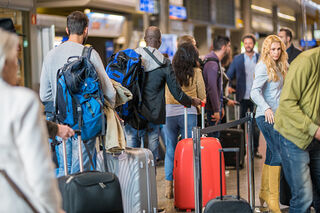Stress
Why Do I Get Migraines With Air Travel?
Here are some obvious and not-so-obvious reasons.
Posted July 11, 2022 Reviewed by Jessica Schrader
Key points
- Triggers and warning signs for migraine attacks are abundant with air travel, particularly now.
- Stress, routine changes, sleep disruption, and environmental reasons are all factors.
- Planning ahead in every way is key.

As I finally boarded the first leg of my plane travel overseas, my first triggers and warning signs had already struck—significant stress and anxiety, the weight of my carry-on, not eating at regular times, and not being able to find anything healthy to eat at the airport. I had been struggling through a three-hour delay, which inevitably meant I wouldn’t make my connecting flight at the other end, so when I finally boarded the crowded plane and realized I’d be in the second to the last row, I knew I was in trouble. Thankfully for me, though, this part of the trip was short.
As a chronic migraine sufferer, one of the first things I think about when taking a trip by plane is, at what point in the journey will the migraine attack threaten or actually hit?
Indeed, I had missed my connecting flight and would now need to stay at a humble hotel near the airport and catch a 6:30 a.m. flight the next day. Try to envision all the inevitable signs of migraine trouble wrapped up in only this part of the journey:
- Stress
- Routine change
- Sleep disruption
- Poor eating
- Changes in pressure and altitude
Stress can come from a fear of flying, all of the necessary planning, organization, last-minute jobs necessary to get away, delayed flights, missed connections, inability to eat the right foods or at your usual times, and delays in taking medications (sometimes due to time changes), or just the crowds and lines.
Routine changes start as soon as or before you leave home. As someone with migraine, I know my scheduled routine is fundamental. Changes here can lead to poor sleep, lack of sleep, and poor eating habits: “We know the migraine brain doesn’t like change—essentially, any upset to your usual routine, whether it’s disturbed sleep or a skipped meal, can trigger a migraine attack. As travel often involves sudden change to your usual daily routine, particularly if it involves waking up very early or time differences, it can trigger an attack” (Baxter).
Changes in barometric pressure and altitude can trigger migraine, and plane cabins have very low humidity, which can dehydrate you: "The interesting question is whether it's the change in barometric pressure or the change in oxygenation that triggers pain. It is known experimentally that low oxygen levels are a migraine trigger, but there is also a notion that even if you didn't change oxygen levels, changing barometric pressure is also potentially a migraine trigger. It may, therefore, be either one of those, or both in combination, that are responsible for causing high altitude headache and migraine" (Dumas).
The larger question then becomes, what can we do to prepare ourselves to alleviate some of the potential problems that come with air travel?
Stress
I can attest to the fact that air travel is more stressful and exhausting than it has ever been. Flight delays, both going and coming, on my recent trip cost me a full day at my destination, left me with three nights in very modest hotels due to rebooking canceled or missed flights, loss of sleep and lack of healthy food (one hotel offered the choice of hot dogs or chicken fingers and fries to those of us stranded there overnight), lack of sufficient sleep, long hours standing in line at baggage, security, and passport lines, and neck problems due to the necessary weight of my preventative and emergency packs in my carry-on backpack.
- Plan your flights with three hours of layover time between legs. No longer is it possible to book your flights with one or two hours of time. Because of staff shortages, weather events, or mechanical problems, expect delays, and then just be grateful if there are not any. Doing so will prevent the stress and anxiety of rushing through airports, missing connecting flights, standing in line to get rebooked, and more delays.
- Practice breathing/relaxation techniques using available apps. Do some stretching before boarding and get up during long flights to stretch and walk the aisles.
Routine changes
According to Rachel Baxter at The Migraine Trust, the migraine brain doesn’t like change and these routine changes can trigger an attack.
- Be certain to have your rescue medications easily available in your carry-on, and try to maintain your medication schedule, and drink plenty of water before and throughout the flight to keep from dehydration. Since sleep is so important but so difficult on a plane, consider carrying an eye mask, ear plugs, something for neck support, some soothing music, and bring some healthy snacks to eat throughout your flight.
- While they take up a lot of room and weight in your carry-on, keep all your migraine medications with you to prevent any issues if your hold luggage gets lost or delayed. I was without my baggage for the three nights in the airport hotels and another two days until it caught up with me at my destination. Think of the time I would have been without critical preventative and rescue medications. Also, always pack at least an additional two days’ worth, in case you are stranded beyond when you anticipated getting home.
Environmental changes
- If possible, avoid seats at the very back of the plane, where the worst sounds and smells and lines often are.
- Try to get an aisle seat, so you can easily get up to stretch and move around.
- Drink a lot of water.
Lastly, remember that the migraine we often forget is a very common one—the after-stress migraine attack, the “comedown” or “letdown" migraine, which occurs when our system “lets down” after a stressful period, like those we often get after a big exam or interview or after the holidays. Be ready for this potential travel threat, as well, so you don’t lose that quality, well-deserved vacation time.
Remember, your precious vacation travel is the last time you want to be coping with migraine attacks, so do the preventative care you can, remember the on-flight tips, and practice those relaxation techniques when waiting in expected long lines.
Bon voyage!
References
Baxter, Rachel. “Migraine and Travel.” The Migraine Trust. June 2022. https://migrainetrust.org/news/migraine-and-travel.
Dumas, Paula. “Get a Headache on the Plane? Know This Before Boarding. Migraine Again. May 2022. https://www.migraineagain.com/avoid-headaches-when-flying/




